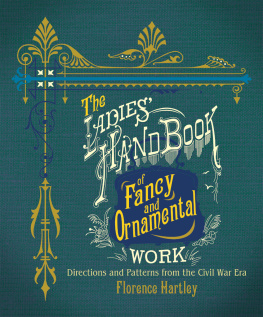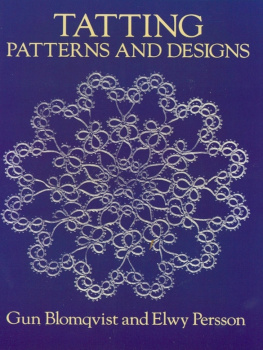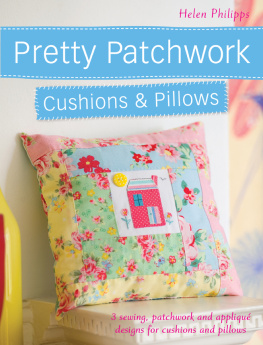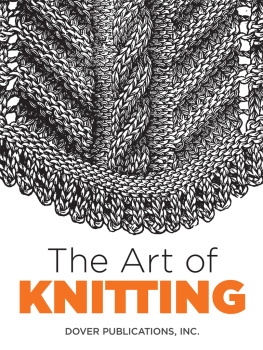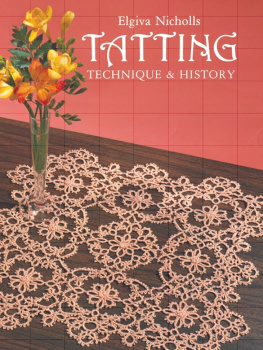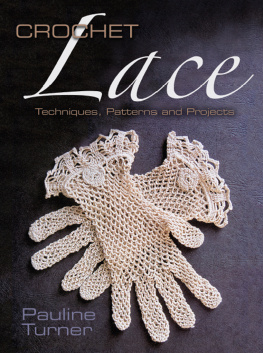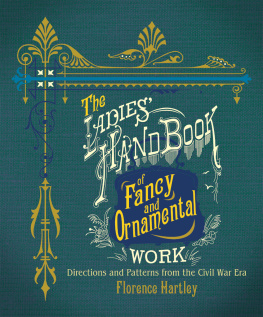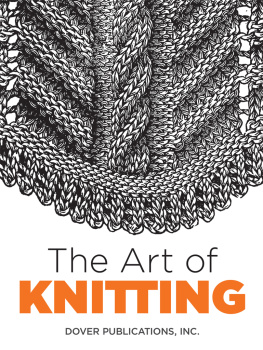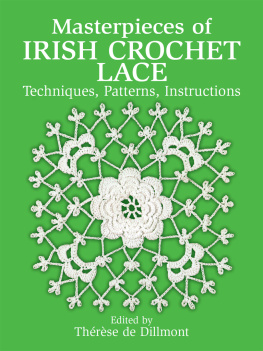
EMBROIDERY.
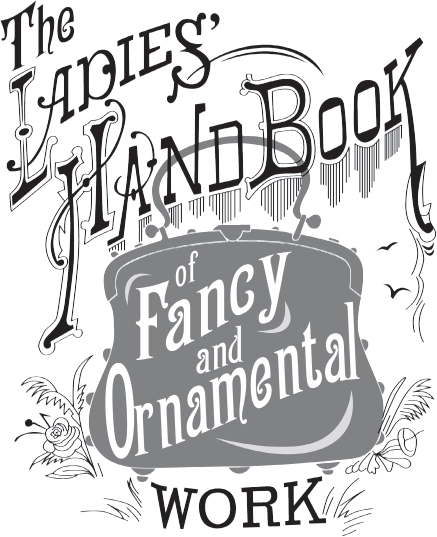
Directions and Patterns from the Civil War Era
Florece Hartley
DOVER PUBLICATIONS, INC.
Mineola, New York
Bibliographical Note
This Dover edition, first published in 2016, is an unabridged republication of the work originally published by the Keystone Publishing Co., Philadelphia, Pa., in 1889 [first edition: 1859].
Library of Congress Cataloging-in-Publication Data
Names: Hartley, Florence, author.
Title: The ladies hand book of fancy and ornamental work: directions and patterns from the Civil War era / Florence Hartley.
Other titles: Ladies handbook of fancy and ornamental work
Description: Mineola, New York: Dover Publications, 2016. | Reprint. Originally published Philadelphia, Pennsylvania: Keystone Publishing Company, 1889. A first edition was published in 1859.
Identifiers: LCCN 2016018397| ISBN 9780486809113 (paperback) | ISBN 0486809110 (paperback)
Subjects: LCSH: Fancy work. | BISAC: CRAFTS & HOBBIES / Needlework / Embroidery. | CRAFTS & HOBBIES / Needlework / Lace & Tatting. | CRAFTS & HOBBIES / Beadwork. | CRAFTS & HOBBIES / Needlework / Crocheting. | CRAFTS & HOBBIES / Needlework / Knitting. | CRAFTS & HOBBIES / Papercrafts. | CRAFTS & HOBBIES / Needlework / Needlepoint.
Classification: LCC TT750.H33 2016 | DDC 746.4dc23 LC record
available at https://lccn.loc.gov/2016018397
Manufactured in the United States by RR Donnelley
80911001 2016
www.doverpublications.com
PREFACE.
I N the preparation of this work for the press, the writer has endeavored to furnish all that is essential to the proper understanding and practice of ornamental and fancy work, in the plainest language, without introducing unnecessary and irrelevant topics. Nearly all the patterns for needle work, and other parts of domestic adornment used in this country, are derived from English, French, and German sources; and of these the compiler has freely availed herself, adding to them such original patterns as were at her command.
For some of the directions given, she is indebted to Miss Lamberts Guide, and to several anonymous English, French, and German works; and she has adopted the alphabetical order in the arrangement of the subjects, as in Mrs. Pullans excellent Ladys Manual of Fancy Work. The compilers own experience and practice have enabled her to supply a large amount of original information in the several departments of the work. The large number of working patterns, of various descriptions, distributed throughout this book, she trusts will be recognized as a very important feature, and one which will greatly promote the main object which she has kept constantly in viewreal practical utility.
LADIES HAND BOOK
OF FANCY AND ORNAMENTAL WORK.

APPLIQU, OR APPLICATION.
A PPLIQU , or application, is the laying of one kind of material over another. Pieces of different forms and colors are placed one over another, and secured at the edges by braids, cords, or embroidery. If neatly done and arranged with taste and ingenuity, it is exceedingly handsome. It has been applied very successfully to ladies cloaks, for some years past.
Appliqu may be used on any material, such as cloth, velvet, silk, leather, or muslin, and lace. In forming the pattern, it should be carefully drawn on the material intended for the appliqu, and a corresponding one on that intended for the ground, which may consist of the same or other material. Velvet can be beautifully arranged upon cloth, or satin upon velvet, or silk upon satin, muslin on lace, or lace upon muslin. If velvet, satin, or silk is used, it is necessary to paste a thin paper over the back, before the appliqu is cut, to render it firm and prevent its unraveling. The pieces, when cut, are to be carefully tacked down on the material, and the edges secured either by cord, braid, or satin-stitch embroidery, varying the colors according to taste. Where flowers are chosen, the color of the flowers or leaves is preferable. What are called Turkish designs are peculiarly suited for this kind of work. Vine leaves are also very handsome, and the tendrils can be formed by cord, chenille, &c.
For bags of various kinds, merino and cashmere can be used, making the appliqu of velvet and silk. This is also suitable for slippers, sofa-pillows, &c. It can be edged with gold cord, or braid, or chenille. Slippers of kid, with velvet appliqu, or velvet slippers with kid appliqu are very handsome.
A set pattern is much the handsomest for table covers, ottomans, or large pieces of work.
As appliqu requires stamping tools and machinery for any extensive piece of work, it can only be used by private persons, on a comparatively small scale; but when neatly done, for bags, slippers, ottomans, &c., it richly repays the trouble taken.

LADIES TRAVELING BAG.
The two sides of this beautiful traveling bag are made of gray leather, or cashmere. The black pattern is cut from velvet, and fastened on with gum and a carefully sewn edgethe white spots are beadssteel beads to be preferred. The pattern may be drawn of any size desirable, on writing paper, and then traced with a sharp-pointed bodkin, through the paper on the leather.
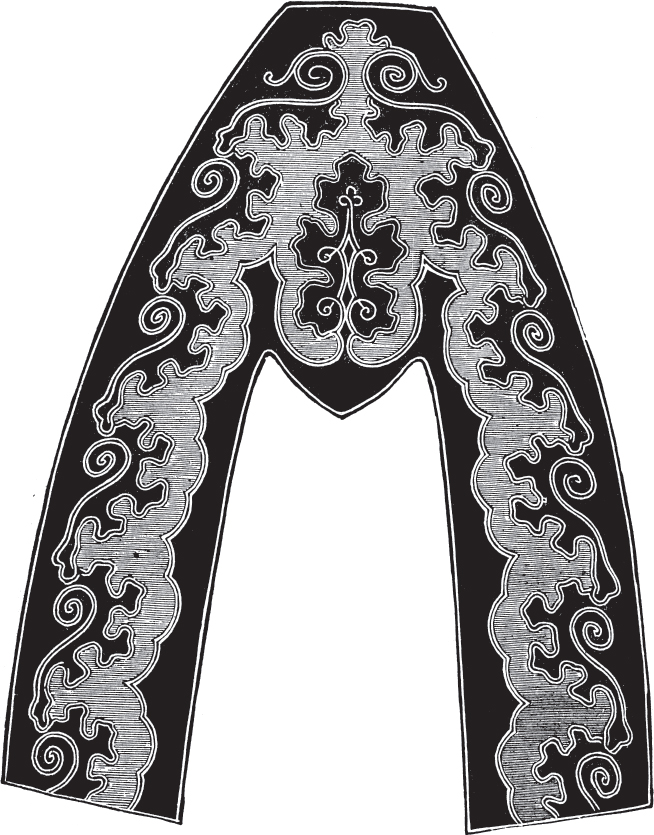
SLIPPEK IN APPLIQU.
SLIPPER, IN APPLIQU.
M ATERIALS .Half a yard of the finest black cloth; nearly the same quantity of scarlet or crimson velvet. Gold thread, of the finest quality, No. 3, two skeins; and fancy cord, of the color of the velvet.

SLIPPER.
Cut out of a sheet of foolscap paper, the exact size required for the slipper; lay this on the cloth, and mark the outlines of the slipper with white thread. Then draw the pattern, enlarging it to the required size.
Draw only one-half of the slipper, and mark the other half from it. The parts engraved in white horizontal lines, are to be velvet, which is cut out in the proper shape, that for each slipper being in one entire piece.
Take a broad paint brush, and wash over the back of the velvet lightly with very thin glue; then lay it on the cloth, and tack it, to keep it in its place. Lay it, with the velvet side downwards, on a thickly folded cloth, and put some books on it as weights, until the velvet and cloth adhere. The velvet chosen should be of the best description, with a very short pile. If at all crushed, a warm iron may be held upright, and the back of the cloth passed lightly over it. This will raise the pile. The edges of the velvet are finished off with two lines of gold thread, between which the fancy cord is laid. They are respectively to be sewed over with silk of the same colors, and the ends drawn through the cloth. Quilted silk or satin should be used for lining these slippers.
BEAD WORK.
T HIS work is done in tent-stitch, on canvas, of silk or imitation silk. The beads must be very carefully adapted to the canvas, that each one may just cover the space allotted to it.
Next page
